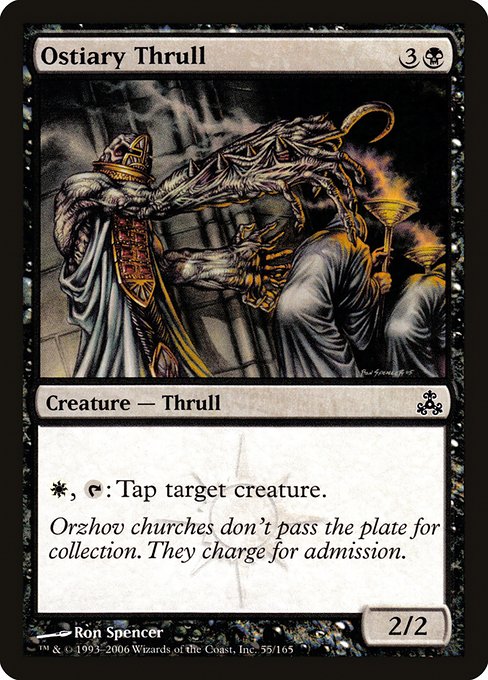
Image courtesy of Scryfall.com
Randomness in Un-set mechanics through the lens of Ostiary Thrull
Magic: The Gathering has always thrived on a balance between deliberate, skillful play and the delightful chaos of chance. When you tilt toward the light-hearted chaos of Un-sets— Unglued, Unhinged, and friends—you lean into randomness as a design feature: wacky themes, goofy cards, and moments that surprise you more than a well-timed bluff. The Un-set philosophy invites players to embrace unpredictability, to laugh at the sheer whimsy of the game, and to celebrate the human element of play that no perfect tempo chart can predict 🧙♂️🔥. Yet even within that carnival of chaos, there are anchors—cards and mechanics that remind us what strategic play feels like when you’re not simply rolling a die and hoping for the best. This is where Ostiary Thrull steps in as a sober counterpoint to random vibes, a steady black-white workhorse that channels control and utility into a chaotic playground.
Ostiary Thrull: a screenshot of classic black-white tempo
Printed in Guildpact, a set steeped in the lore of the Orzhov Syndicate, Ostiary Thrull is a true beliefs-and-banter card. It’s a common creature—2/2 for 4 mana with a white activation cost—that reads simply but with teeth: {W}, {T}: Tap target creature. The color identity is telling: black with a white activation cost, a cross-section of the Orzhov ethos—profit, control, and inexorable efficiency. The art by Ron Spencer captures that austere, ceremonial feel that marks the Orzhov guild: order, ritual, and the uncomfortable truth that power often asks for a price. The flavor text, “Orzhov churches don't pass the plate for collection. They charge for admission,” lands the flavor of a courtly, calculating hierarchy 🧭.
In practical terms, Ostiary Thrull is a tempo engine with a restraint key: you pay W up front to lock down a problem on the battlefield, buying time while you assemble a deeper plan. It’s not flashier than a mythic annihilator, but it’s dependable. In multiplayer commander formats or casual kitchen-table games—contexts where Un-set chaos tends to flourish—this creature shines as a stabilizing force. You can incrementally strip away threats with a steady hand, or use the threat of its tapping ability to coerce opponents into suboptimal plays. When the table is busy juggling chaos tokens, the Thrull’s tap ability remains a rare moment of clarity—a reminder that predictable pressure can be a potent weapon, too ⚔️.
From a design perspective, Ostiary Thrull embodies a balanced mana curve and a clean, repeatable effect. It doesn’t win the game on the spot, but it reshapes the battlefield in a way that aligns with both the black and white sides of its identity. That synergy—where white’s utility and protection meet black’s removal and tempo—echoes the era of Guildpact, a time when color pairs in magic could reveal new textures of strategy without spiraling into complexity overload. In an Un-set-themed deck, where you’re likely to encounter unconventional answers and unpredictable play patterns, a card like this becomes a steady line of defense or a quiet facilitator for a contrarian game plan 🧙♂️.
Design notes: how Un-set randomness meets a deterministic tool
Un-sets celebrate the unexpected: cards that twist expectations, funny artifacts that encourage wild sequences, and sometimes even rules that bend what “normal” feels like. The randomness shuffle—whether literal or thematic—becomes a social contract: we agree to play with weird stuff, but we still expect certain corners to feel crisp and reliable when the situation calls for it. Ostiary Thrull feels like a counterbalance to that idea. It’s a predictable, easily understood effect that can be deployed in a surprising moment, allowing players to weave a thread of control through a tapestry of jokes and chaos. The card’s relatively modest stats (2/2 on a 4-mana body) ensure that the activation cost (white mana to tap) remains fair, while the blue-sky possibility of “what if the table rolls a die and suddenly every creature is tapped” remains a playful narrative rather than a broken engine 🔮.
For players who enjoy the lore, the card’s background in Orzhov doctrine adds a layer of thematic flavor to the gameplay. The guild’s focus on structure, contracts, and consequences informs every use of the Thrull: you’re trading tempo for leverage, you’re imposing a condition on the battlefield, and you’re reminding everyone at the table that in this game, even a small action can tilt the balance of power. The Un-set crowd might revel in randomness, but the grounded, tactical voice of Ostiary Thrull is a welcome chorus—an anchor that helps players navigate the storm of playful mischief with a smile 🧩.
And if you’re building around the Un-set vibe in a modern casual scene, you can lean into that contrast with a playful, control-forward deck list: remove a few obvious threats with surgical taps, deploy timely accelerants, and let the table enjoy the spectacle while you hold a quiet ace in your hand. The key is to respect the chaos while still demanding informed decisions—because that tension between randomness and control is what makes the format feel alive, memorable, and absolutely MTG 🔥.
On a merchandising note, there’s a lighthearted parallel to draw: keeping your play space tidy and accessible can extend the fun well beyond the table. A sleek, MagSafe-compatible phone case with a card holder—like the product linked below—lets you carry a few play notes, a bookmark card, or a reference sheet on the go, without sacrificing style. It’s a small nod to the way a well-designed card can blend form and function, just as a well-timed Thrull tap blends tempo and control in a game that loves a good story as much as a good punchline 🧙♂️💎.
Phone Case with Card Holder MagSafe Compatible Slim PolycarbonateMore from our network
- https://crypto-acolytes.xyz/blog/post/the-rise-of-cooperative-horror-experiences-shared-fear-reimagined/
- https://blog.digital-vault.xyz/blog/post/harnessing-ai-for-deeper-campaign-insights/
- https://transparent-paper.shop/blog/post/realistic-shadow-mapping-on-digital-paper-layers/
- https://crypto-acolytes.xyz/blog/post/mastering-npc-scientist-fights-in-rust-proven-tactics/
- https://blog.digital-vault.xyz/blog/post/evaluating-innovation-risk-in-soulscours-card-design/